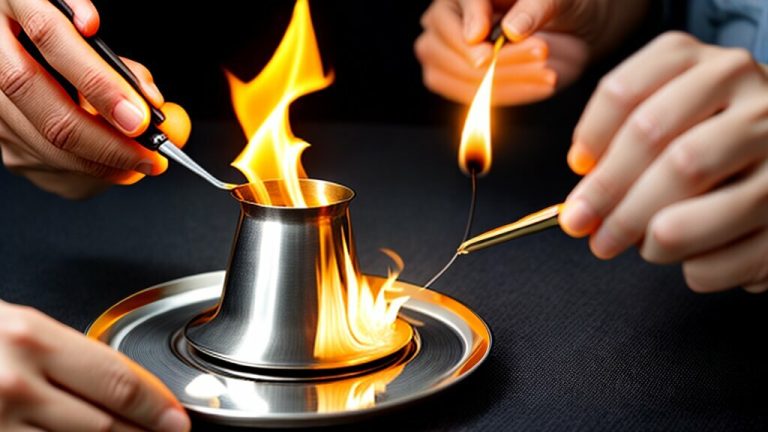Many methods are available when it comes to testing the authenticity of silver. One of the most popular and accessible methods is using a lighter. By following a few simple steps and using some basic materials, you can quickly and easily determine whether or not your silver item is real.
This article will guide you through testing silver authenticity with a lighter. We will explain why using a lighter is effective, what materials are necessary, and how to interpret the results. Additionally, we will offer some tips for accurate testing and safety precautions to take and know how to start a charcoal grill without lighter fluid.
Key Takeaways
- The lighter test is a common and reliable method for testing silver authenticity.
- Gathering the necessary materials, conducting the test, and interpreting the results are all important steps.
- It’s important to take safety precautions when testing silver with a lighter and to be aware of alternative testing methods.
Why Use a Lighter to Test Silver Authenticity?
When it comes to testing silver authenticity, there are various methods available, but using a lighter is one of the most popular and accessible options. This method is based on the fact that silver has a high thermal conductivity, meaning it can quickly transfer heat. You can determine whether a piece of silver is genuine by conducting a simple test with a lighter.
Using a lighter to test silver is also widely accepted because it is non-destructive and does not require specialized equipment. It is a quick and easy way to identify real silver, especially if you are not an expert.
“The lighter test is a simple yet effective way to determine if your silver item is real or not.”
It is important to note that while the lighter test can give you a good indication of silver authenticity, it is not a foolproof method. Other tests may be necessary to confirm the results or to detect more subtle differences between real and fake silver.
Gathering the Necessary Materials
Before you conduct a silver test with a lighter, you must gather a few essential materials. Here is a list of what you will need:
| Materials | Description |
|---|---|
| A silver item | You will need a piece of silver to test its authenticity. It can be a coin, jewelry, or any other item made of silver. |
| A lighter | You will need a lighter to apply heat to the silver item. |
| Protective gear | It is recommended to wear protective gear such as gloves and safety glasses when conducting a silver test with a lighter. |
Select the silver item you want to test carefully and have all the necessary materials ready before starting the test.
Conducting the Silver Test with a Lighter
Now that you have gathered the materials for testing silver authenticity with a lighter, it’s time to conduct the test. Follow these step-by-step instructions:
- Put on your protective gear, including gloves and eye goggles.
- Hold the silver item firmly with a pair of pliers or tongs.
- Use a lighter to apply a small flame to the item’s surface. Hold the flame on the silver for a few seconds.
- Observe the silver item closely. If it starts to turn black or emit black smoke, it may be fake silver. If it remains unchanged, it may be real silver.
- If the silver item changes color, remove it from the flame and let it cool down. Then, wipe the surface with a clean cloth or cotton swab.
- Inspect the area where the flame was applied. The item may be fake silver if there is a black mark or residue. If there is no mark, it may be real silver.
It’s important to note that this method is not foolproof and may not work for all silver items. It’s also important to be cautious when handling the lighter and the silver item, as they can both get very hot during the testing process.
Understanding the Results
After conducting the silver test with a lighter, there are three possible outcomes: the item is real silver, not silver, or the result is inconclusive.
Real Silver
If the silver item passes the lighter test, it will likely be real silver. You may notice a few indications of the metal’s authenticity. First, after heating the silver, it should cool down quickly. Additionally, the silver should tarnish over time and develop a beautiful patina that only genuine silver can create. Lastly, real silver will make a distinctive sound when struck, known as a “ring test.”
It is important to remember that even genuine silver items may contain other metals, such as copper or nickel, which can affect the sound and tarnish properties.
Not Silver
If the item fails the lighter test, it is not made of silver. This could mean it is entirely made of a different metal or silver-plated rather than solid silver.
If you suspect the item to be silver-plated, you can check for a hallmark. Silver-plated items often have a hallmark of “EPNS,” which stands for “electroplated nickel silver.”
Inconclusive Results
In some cases, the results of the lighter test may be inconclusive. This means that the item did not pass or fail the test. In these instances, using another testing method or consulting with an expert may be necessary.
It is also important to note that while the lighter test is a quick and easy method for testing silver authenticity, it may not always be accurate. Therefore, it is recommended to use multiple testing methods to confirm the result.
Additional Methods for Testing Silver Authenticity
While using a lighter to test silver authenticity is a commonly used method, other options are available. These methods may require additional materials or equipment, but they can be more accurate and reliable than the lighter test in certain cases.
Acid Test
The acid test is a popular method for testing silver purity. It involves applying nitric acid to the silver item and observing the reaction. The acid will dissolve non-silver metals, leaving only the silver intact. This test can determine the exact purity of the silver, but it should be done with caution as the acid is corrosive and can damage the item being tested.
Magnet Test
The magnet test is a quick and easy method for determining if an item is made of pure silver. Since silver is not magnetic, a silver item should not stick to a magnet. If the item sticks, it is likely made of a different metal or has a silver coating.
Professional Testing
If you are unsure about the authenticity of your silver item, you can have it tested by a professional. Jewelers and appraisers have the necessary equipment and expertise to determine silver purity and authenticity accurately. This option may be more expensive than the other methods, but it can provide the most accurate results.
While these additional methods can be more accurate and reliable than the lighter test, they may not be as accessible or convenient. For quick and easy testing, using a lighter can be a useful option.
Tips for Accurate Silver Testing
Testing the authenticity of silver with a lighter can be a simple and accessible method. However, to ensure accurate results, it’s important to follow these tips:
- Conduct the test in a well-ventilated area: When testing silver with a lighter, fumes may be released that can be harmful if inhaled. It’s important to conduct the test in a well-ventilated area or use protective gear, such as a mask.
- Handle the silver item carefully: hold it with tweezers or pliers rather than your fingers to prevent damage to the silver item. This will also prevent oils from your skin from affecting the test results.
- Use a clean lighter: Any debris or residue in the lighter can affect the test results. It’s important to use a clean and functioning lighter to keep the flame consistent.
- Observe the color of the flame: The color of the flame can indicate the purity of the silver. It’s important to observe the color and compare it to a reference guide for accurate results.
- Conduct multiple tests: To ensure accuracy, conduct the test multiple times with different parts of the silver item. This will help verify the silver’s authenticity and identify any inconsistencies in the results.
- Avoid common mistakes: Finally, it’s important to avoid common mistakes such as holding the lighter too close to the silver or not allowing it to cool before handling it. These mistakes can affect the test results and lead to inaccurate conclusions.
By following these tips, you can conduct accurate and reliable silver testing with a lighter.
Ensuring Safety during Silver Testing
Safety should be a top priority when testing silver authenticity with a lighter. The following guidelines will help ensure that you perform the test safely:
- Wear protective gear, including gloves and eye protection, to avoid injury from sparks or hot metal during the test.
- Perform the test in a well-ventilated area to avoid inhaling fumes when burning the silver.
- Ensure that the lighter is functioning properly and that no leaks or malfunctions could cause injury.
- Always handle the silver item carefully to avoid damaging it or causing injury to yourself. Use tongs or pliers to hold the item during the test.
By following these safety precautions, you can ensure that you perform the silver test with a lighter safely and effectively. Remember always to prioritize your safety and the safety of those around you when conducting any test or experiment.
Conclusion
Testing silver authenticity with a lighter is a simple and effective method that can be used to distinguish real silver from fake. Following the steps outlined in this silver testing guide, readers can confidently conduct the test and interpret the results accurately.
While using a lighter to test silver authenticity is a popular and accessible option, readers may also consider other testing methods, such as acid testing or professional appraisal.
It is important to exercise caution and practice safety when conducting the silver test with a lighter. Always handle the lighter and silver items with care and wear proper protective gear.
With these tips and guidelines in mind, readers can ensure accurate and safe testing of silver authenticity with a lighter.

I’m Alfred Davis, and I’m all about lighters. Hailing from the great state of Texas, USA, I’ve cultivated a deep passion for these fascinating gadgets. With years of hands-on experience and a burning curiosity (pun intended), I’ve become an expert in all things related to lighters.
My journey with lighters began as a hobby and quickly became a full-blown obsession. I’ve explored the diverse world of lighters inside and out, from classic Zippo designs to modern plasma arc models. I’ve tested, tinkered with, and even collected rare pieces while learning the intricate mechanics and unique histories behind each one.
Through my writing, I aim to share my knowledge, insights, and reviews to help you make informed decisions about choosing the perfect lighter. Whether you’re a seasoned collector or just looking for a reliable fire source, I’ve got you covered. Join me in unraveling the fascinating realm of lighters right here at LightersInfo, where ignition meets expertise.
Alfred Davis

